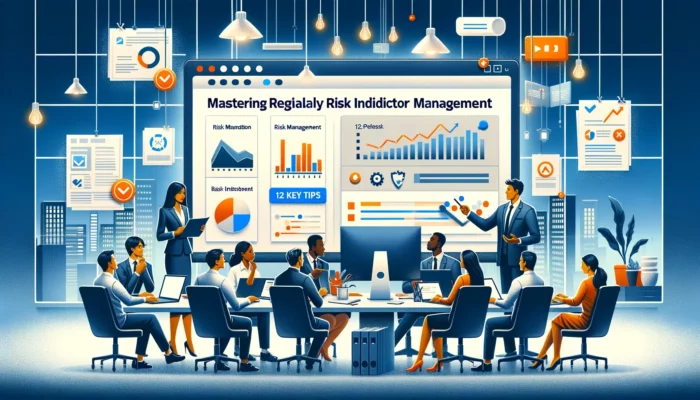Key Risk Indicators (KRIs) in the insurance industry are metrics used to early identify potential losses or risks that the company might face. Some examples of KRIs for an insurance company might include:
- Claim Frequency: The number of claims received over a certain period can indicate the level of risk associated with a particular line of insurance.
- Claim Severity: The average cost per claim can help insurers understand the potential impact of claims on their financials.
- Loss Ratio: This is the ratio of losses paid to premiums earned and can indicate the profitability of insurance products.
- Policy Lapse Rates: High rates could indicate customer dissatisfaction or an increased risk of not having sufficient policies in force to cover claims.
- Underwriting Expense Ratio: The expenses incurred in the underwriting process as a percentage of premiums can highlight the efficiency of the underwriting process.
These examples are general and can vary depending on the specific area of insurance and the particular risks that an insurer wants to monitor.
For detailed examples and explanations of KRIs, industry-specific resources and publications would be the best point of reference.
Key risk indicators in the insurance sector are essential for evaluating underwriting, claims management, financial performance, compliance assurance, and market volatility.
Underwriting risk indicators help in pricing strategies and decision-making, while claims management indicators track claim effectiveness.
Financial risk indicators evaluate performance based on incurred losses and operational efficiency.
Compliance risk indicators guarantee adherence to regulations. Market risk indicators monitor pricing trends.

Further exploration of these indicators can provide deeper insights into effective risk management strategies.
Key Takeaways
- Underwriting risk indicators assess the likelihood of claims and inform pricing strategies.
- Claims frequency trends offer insights into claims management effectiveness.
- Financial risk indicators evaluate performance and optimize costs for stability.
- Compliance risk indicators monitor adherence and aid in risk mitigation.
- Policy adherence assessment includes completeness of documents and corrective actions.
Underwriting Risk Indicators
Underwriting risk indicators play a vital role in the insurance industry by providing insights into the potential risks associated with underwriting policies.
These indicators help insurance companies assess the likelihood of claims and determine appropriate pricing strategies to manage risks effectively.
Understanding the different types of key risk indicators is essential for insurers to make informed decisions and maintain financial stability.
Definition of key risk indicators in the insurance industry
In the insurance industry, key risk indicators serve as essential metrics used to assess and manage the potential risks associated with underwriting activities.
These indicators play a significant role in operational risk management and are integral to an enterprise risk management strategy.
Key insurance KPIs help organizations monitor their underwriting performance effectively. Utilizing insurance dashboard software can enhance the visualization of these key risk indicators, aiding in quicker decision-making processes.
Additionally, insurance reporting solutions enable companies to track and analyze trends in underwriting risks efficiently.
Insurers can optimize their underwriting processes and proactively manage emerging risks by focusing on these insurance performance indicators.
Importance of key risk indicators in insurance
Effective risk management in the insurance industry relies heavily on the utilization of key risk indicators to gauge and address potential underwriting risks.
These indicators play a vital role in helping insurance companies assess their risk exposure, enabling them to develop a robust risk management strategy.
By monitoring key risk indicators, insurers can proactively identify and mitigate operational risks, ensuring the stability of their operations.
Incorporating key risk indicators into the risk management process enhances the effectiveness of risk management activities, providing valuable insights to the risk team.
Understanding the importance of these indicators allows insurance companies to make informed decisions, strengthen their risk management framework, and ultimately safeguard their financial well-being.
Types of Key Risk Indicators
Utilizing specific metrics to assess potential risks associated with insurance underwriting is essential for maintaining a secure and stable operational framework.
When it comes to underwriting risk indicators, various factors and metrics play an important role in identifying key risks and ensuring effective risk detection.
Some significant types of key risk indicators in insurance underwriting include:
- Risk factors that influence underwriting decisions.
- Different risk categories, such as market risk and credit risk.
- Various risk scenarios could impact underwriting outcomes.
- Sources of risk that need to be monitored closely.
Claims Management Indicators
Claims Management Indicators in insurance assess key aspects like claim frequency trends and the severity of losses incurred by policyholders.
These indicators provide valuable insights into the performance of an insurance company in managing and settling claims efficiently.

Claim Frequency Trends
An analysis of the current claim frequency trends reveals significant insights into the efficiency of insurance claims management practices.
- Key Performance Indicators: Tracking claim frequency helps the risk management team assess the effectiveness of their strategies.
- Risk Assessments: Monitoring claim frequency aids in identifying potential risks and evaluating current risk levels.
- Warning Signs: Sudden spikes in claim frequency can serve as warning signs of underlying issues that require attention.
- Ongoing Risk Monitoring: Continuous analysis of claim frequency trends allows for proactive measures to mitigate the financial impact and maintain customer satisfaction.
Severity of Losses
A critical aspect of effective claims management in the insurance industry is evaluating the magnitude of losses incurred, known as the severity of claims.
Understanding the severity of losses is vital for insurers to assess their risk appetite and the potential impact on their financial standing.
By analyzing the severity of losses, insurers can better tailor their risk profile to mitigate various types of risk, such as market risk and conduct risk.
This evaluation helps in identifying key risk indicators (KRIs) that signal potential impacts on the business.
Additionally, it fosters accountability within business units to proactively manage and address the financial risks associated with high-severity claims, ensuring a robust risk management framework is in place.
Financial Risk Indicators
Financial risk indicators play a vital role in evaluating the stability and performance of insurance companies.
Loss ratio, a key financial risk indicator, measures the ratio of incurred losses to earned premiums, indicating the insurer’s underwriting profitability.
Similarly, the expense ratio, another significant indicator, evaluates the efficiency of an insurer in managing its operational costs relative to its premium income.
Loss ratio
Reflecting the relationship between incurred losses and earned premiums, the loss ratio is a critical financial risk indicator in the insurance industry.
- Helps in evaluating the financial performance of the insurance company.
- Affects the customer satisfaction score and business objectives.
- It is a key risk indicator used in risk management strategies.
- Influences stakeholders and control owners in decision-making processes.
Expense ratio
The expense ratio is an important metric in insurance that provides insight into the operational efficiency of an insurance company.
It is a key risk indicator used in risk management within financial institutions to assess the expenses incurred by the business unit in relation to its revenue.
Monitoring the expense ratio in real time helps identify cash flow risks, compliance risks, and risks to customer satisfaction.
By analyzing this ratio, insurers can streamline their operations, optimize costs, and guarantee sustainable profitability.
Maintaining a healthy expense ratio is essential for financial stability and competitiveness in the insurance industry, making it a critical component of effective risk management strategies.
Compliance Risk Indicators
In the domain of insurance, Compliance Risk Indicators play a pivotal role in ensuring adherence to regulatory requirements.
These indicators encompass Regulatory Compliance Monitoring, which involves tracking and evaluating adherence to laws and regulations.
Additionally, Policy Adherence Assessment and the implementation of Risk Mitigation Strategies are vital components in managing compliance risks effectively.

Regulatory Compliance Monitoring
Consistently monitoring regulatory compliance is essential for insurance companies to mitigate compliance risk and uphold industry standards.
- Utilizing key risk indicators: Implementing specific metrics to track regulatory compliance effectiveness.
- Leveraging monitoring tools: Employing specialized software to oversee compliance adherence.
- Analyzing regulatory risks: Identifying potential compliance issues through thorough risk assessments.
- Enhancing reporting mechanisms: Improving reporting tools to guarantee accurate documentation of compliance posture.
Policy Adherence Assessment
Ensuring policy adherence is a critical component of evaluating compliance risk indicators in the insurance industry.
Evaluating whether internal controls and processes align with established policies is essential for effective risk management.
Risk owners play a pivotal role in monitoring policy adherence and initiating remedial action when deviations are identified.
Below is a table illustrating key risk indicators for policy adherence assessment in insurance:
| Risk Indicator | Description |
|---|---|
| Policy Documentation | Completeness and accuracy of insurance policy documents |
| Training Programs | Adequacy of training provided to employees on policy adherence |
| Audit Findings | Number and severity of policy adherence issues identified in audits |
| Compliance Reviews | Frequency and results of compliance reviews conducted internally |
| Corrective Actions | Timeliness and effectiveness of remedial actions taken |
Risk Mitigation Strategies
Effective compliance risk mitigation strategies are essential for safeguarding insurance companies against regulatory non-compliance.
To effectively manage compliance risks, risk managers should consider the following strategies:
- Implementing key risk indicators to monitor regulatory adherence.
- Integrating compliance into enterprise risk management processes.
- Aligning risk mitigation strategies with strategic goals.
- Establishing clear warning signals for potential compliance breaches.
In today’s digital environment, where customer complaints and conduct risks can quickly escalate, having robust risk mitigation strategies is vital.
Insurance companies can navigate regulatory complexities and protect their reputation by gaining internal acceptance and proactively addressing compliance challenges.
Market Risk Indicators
Market Risk Indicators in insurance play a pivotal role in evaluating the potential impacts of fluctuations in pricing volatility trends, appraising the risks associated with underwriting processes, and ensuring compliance with regulatory standards.
Insurers can anticipate market shifts by monitoring pricing volatility trends and effectively managing risks.
Additionally, conducting thorough underwriting risk assessments allows insurance companies to make informed decisions that align with their risk tolerance levels and overall business objectives.
Regulatory compliance monitoring further strengthens the industry’s resilience by ensuring that insurers adhere to legal requirements, thereby minimizing market-related risks.
Pricing Volatility Trends
Amidst the dynamic landscape of the insurance industry, monitoring pricing volatility trends emerges as an important element in evaluating market risk indicators.
Understanding these trends is essential for evaluating the impact of market conditions on financial metrics and aligning strategies with business goals.
For enterprise-level businesses, staying abreast of pricing volatility is necessary for effective risk management.
Utilizing sophisticated risk management software can aid in tracking these key indicators and providing insights into potential risks.
Underwriting Risk Assessment
A thorough underwriting risk assessment is essential for insurers to identify and manage market risk indicators effectively.
Key risk indicators such as credit risk exposure, cyber risk exposure, and conduct risk are integral components of this assessment.
Insurance companies must analyze cash flows, evaluate risk culture, and align underwriting practices with the strategic plan to mitigate potential market risks.
Management teams play an important role in overseeing the underwriting process and ensuring that risk management strategies are implemented successfully.
Regulatory Compliance Monitoring
Continuing the focus on effective risk assessment within the insurance industry, closely monitoring regulatory compliance is paramount in identifying and managing market risk indicators.
- Holistic Approach: Implementing a thorough strategy to guarantee all regulatory requirements are met.
- Control Environment: Establishing robust internal controls to mitigate compliance risks effectively.
- Escalation Procedures: Developing clear protocols for reporting and addressing compliance issues promptly.
- High-Quality Data: Utilizing accurate and reliable information to assess compliance levels accurately.
Frequently Asked Questions
How Do Key Risk Indicators Differ From Key Performance Indicators in the Insurance Industry?
Key risk indicators in the insurance industry focus on identifying potential risks that could impact the organization’s objectives.
In contrast, key performance indicators measure the effectiveness and efficiency of achieving those objectives. Both are essential for strategic decision-making.
How Do Insurance Companies Determine the Threshold Levels for Key Risk Indicators?
Insurance companies establish the threshold levels for key risk indicators by analyzing historical data, market trends, regulatory requirements, and business objectives.
This process involves a thorough risk assessment to make sure that KRI thresholds are set at appropriate levels.
What Are Some Common Challenges Faced by Insurance Companies When Implementing Key Risk Indicators?
Common challenges faced by insurance companies when implementing risk indicators include data quality issues, defining relevant indicators, aligning with business objectives, ensuring timely updates, and balancing between leading and lagging indicators to manage risks effectively.
How Do Key Risk Indicators Help Insurance Companies in Making Strategic Decisions?
Key risk indicators enable insurance companies to monitor essential factors that impact their operations, providing insights into potential risks and opportunities.
Analyzing these indicators allows companies to make informed strategic decisions to mitigate risks and optimize performance.
Are There Any Industry Standards or Best Practices for Selecting Key Risk Indicators in the Insurance Sector?
In the insurance sector, industry standards and best practices provide guidelines for selecting key risk indicators.
These metrics help in identifying, monitoring, and managing risks effectively to make informed strategic decisions that align with the company’s objectives.

Conclusion
In summary, essential risk indicators in insurance play a vital role in evaluating various aspects of risk within the industry.
Insurance companies can better manage and mitigate potential risks by monitoring indicators for underwriting, claims management, finance, compliance, and market.
These indicators provide valuable insights to help insurers make informed decisions and maintain financial stability in an ever-evolving market environment.

Chris Ekai is a Risk Management expert with over 10 years of experience in the field. He has a Master’s(MSc) degree in Risk Management from University of Portsmouth and is a CPA and Finance professional. He currently works as a Content Manager at Risk Publishing, writing about Enterprise Risk Management, Business Continuity Management and Project Management.

